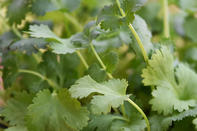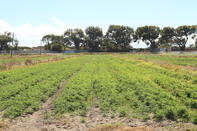
Propagation
Coriander propagation is from seed.
Planting Method
Coriander planting by large commercial growers is more commonly done by direct seeding. The seeds are planted about ten millimetres deep. Coriander seeds germinate reasonably well but it is advisable to sow twice the seeds required and thin out if required.
This is done by mechanical planters or by hand, depending on the size of the operation.
Spacing

Coriander plants should be spaced about 5 cm apart in rows that are 30 cm apart. This is a stand of around 650 000 plants per hectare. Implement and tractor paths are left for management practices and harvesting.
Sowing Time
Sow coriander seeds directly into the fields in early spring. In South Africa that is early September once the threat of frost has lessened.
Growth Period
For fresh coriander production, some producers start harvesting the fresh leaves from as early as five to six weeks from sowing.
Fertilisation
Before planting, a representative soil sample should be taken and sent for analysis. This will identify soil type and nutrient requirements for the intended crop.
For a rough guide, the following recommendation can be used in the absence of soil analysis. An initial 500 kg application of 3:1:5 can be broadcast and incorporated into the top 15 cm to 20 cm of soil prior to sowing. This will give the new coriander plants a good start in establishing themselves.
As coriander does not require much fertiliser, it is best to monitor the growth and then to decide if further nitrogen is required to boost growth. A similar amount of fertigation can be done through the drip irrigation after seeds have germinated and plants emerge.
Irrigation
Most commercial coriander growers install drip irrigation as this is the best way to monitor soil moisture management. The coriander plant can easily go to seed if allowed to become water stressed due to drought.
Therefore, if the coriander is under cultivation to produce fresh leaves, make sure that the plant is adequately irrigated. Do not over irrigate as this could cause root diseases or bacteria on leaves. It is, therefore, best to install moisture measuring devices to continuously monitor the soil.
Depending on soil types and the weather, a good irrigation average is between 25 and 30 mm per week spread over two applications during the warm summer months and reducing irrigation during cooler or rainy months of the year.
Try to avoid irrigating directly before harvest, but irrigate immediately after harvest to restore the optimum moisture content if you wish to stimulate the plant to produce again.